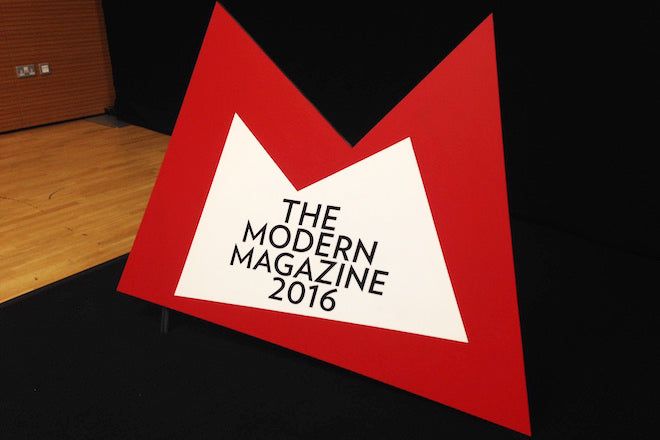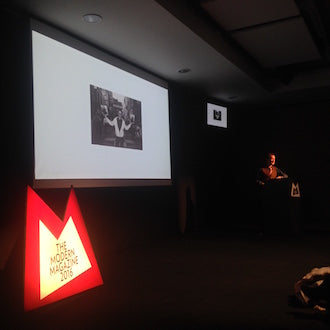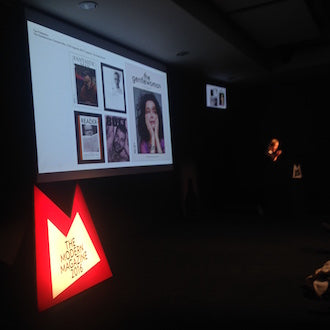
Modern Magazine 2016
Hello and welcome to the live report of ModMag 2016! Madeleine, editor of the magCulture Journal, here. I'm going to be summarizing the talks and collecting Q&As with audience members throughout the day with the help of journalism student Eve Cross.
It's the fourth ModMag conference and we're back this year at Central Saint Martins, which has become almost our home now.
Totes have been handed out, coffees drunk, and we're now all settled in the conference room. Jeremy begins the day off by highlighting a theme of the day and that's the idea of questioning the binary notion of independent vs. mainstream - suggesting that 'big' and 'small' might be a better way of describing.
Has the way of categorising magazines become increasingly problematic and is it time to move the conversation on, especially because what we consider 'indie' can now sell at numbers associated with the 'mainstream'? The binary raises a question: if something is labelled 'independent', it's independent of what?
Our fantastic host Liv Siddall introduces the first speaker...

9.40am: Kirsten Algera, MacGuffin
Joining us from Amsterdam, Kirsten Algara kicks off the day with an introduction to Macguffin.
They explore how simple objects, with careful consideration reveal surprising human experiences. A focus such as a rope acts as a springboard for endearing pieces around how humans destroy and create.
Fed up with the oversaturated design fairs, Kirsten saw a need for an authentic perspective on design as working objects and companions to everyday life. Onto her third issue and looking forward to the future, Kirsten jokes that in the face of adversity in the industry if you haven't got a budget, have a point of view. (ES)

10.00am: Christoph Amend, ZEITmagazin
Christoph goes through the double covers of the title - from 3D Kraftwerk ones to beautifully illustrated summer editions.
"We've been doing this double cover thing for a few years," says Christoph. "So we thought, what do we do now? We experiment with the format." That has meant 40 covers for Claudia Schiffer's 40th birthday and Zeit's 40th issue special, and another issue that was completely cover-less.
He goes on to discuss how 'independents' like Flaneur, mono.kultur, MagGuffin and The Happy Reader have been the inspiring titles for ZEITmagazin this year. 'The question for us then has been: as a newspaper supplement, can we be a part of this?' ZEITmagazin's international edition - which takes the best stories from the German weekly and publishes them in English - has been one potential answer. (MM)

10.40am: Terri White, Empire
The editor of 'the world's biggest film magazine' uses her talk to discuss how to innovate traditional mediums, and how to move into new areas in order to promote an established brand and give it new life. She considers how big brands like Empire are looking at smaller areas in order to grow new kinds of audiences - engaging different viewers through podcasts, live events, and on social media. (MM)
11:15am: Coffee break
We've caught up with some of the conference guests for this first coffee break to find out what magazines they've been reading and what they're enjoying so far...

Les Jones - Elsie Mag (L)
What's the first magazine that you remember?
Goal was a football magazine that I was just totally obsessed with at 8 or 9, I used to cut out pictures and keep them, it was amazing.
Who are you looking forward to today?
The Face was just so huge when we were at Uni, it was seminal when we were growing up and it's going to be a memorable talk.
And your favourite so far?
MacGuffin - so quirky and it's fascinating how they roll on from a simple focus. It's similar to my process at Elsie, to take something simple and go from there.
James De Vries - Harvard Business Review (R)
What's the first magazine that you remember?
Look and Do, it was some children's magazine but I can still ember how it communicated visually to me and was just opening up a exciting, colourful world.
Which talk you enjoyed so far?
MacGuffin is the opposite to my usual approach to the industry and so was really fun to listen to, there was a Dutch wackiness to it. It will remain my favourite, if it hasn't ben beaten by the end of the day...

Harriet Thorne - Financial Times
First mag you remember?
Elle and Harper's: I think they were the only around really
Fave mag today?
Wired, bought it most recently.
And what have you enjoyed the most so far?
Zeit!

Kostya Perkov - Financial Times
What's the first magazine that you remember?
Elle was just the only one around, the first thing I was really exposed to.
Favourite magazine?
I love Trail Runner, it's not indie but I just love it.
Best thing so far?
Zeit was so impressive, the creative way they re imagined a commercial magazine was just fantastic

11.30am: Ladybeard
The Ladybeard team start the second session off by talking through their first sex-themed issue, and how they use the form of a magazine to challenge the glossy and deviate from the kind of ‘Top 10 Ways To Please Your Man’ lists you might find in traditional women’s titles.
"For our second issue, we moved from sex to the mind because we wanted to move from something explicit to something implicit," says co-editor Maddie Dunningan. "Sex as a theme can articulate a lot of primary feminist confirms, but the mind is shockingly absent in the mainstream." In the latest issue, the team have tackled the unhealthy representation of the mind through pieces that look at less digestible mental health topics.
"Mental health is not a problem that needs to be solved, it's about coming to a greater understanding." (MM)

11.55am: Jack Self, The Real Review
Jack Self from The Real Review champions having an ethical thread throughout each of his projects. In line with his social and politically concerned architecture firm which has a board of members, Jack believes that when you review, you look back in order to make propositions for the future. The talk ended with a reminder that during what Jack calls a 'global civil war' in order to offer a substantial contemporary review, the magazine must be responsive and collaborative. As he creates he considers the impact and the integrity of the work they feature, a notion which informs all the decisions of mag and the firm to create 'timeless work'. (ES)

12.15am: Rebecca Nicholson, Vice
Rebecca begins by sharing the story of how she moved from print to digital journalism - starting with her love of making fanzines and reading NME, Bliss, i-D and Dazed, to landing her first job at The Face. After a year as editor-in-chief at Vice UK, she discusses the team's questioning of click-bate culture and their refusal to engage with the notion that audiences have short-attention spans. 'Don't set false limits', 'respect your audience', 'look for the alternative point of view', 'collaborate' and 'never be narrow' are Rebecca's key nuggets of advice. (MM)
Lunch!

Here's our MC Liv Siddall with her verdict so far: 'It's the best ModMag we've had so far. There hasn't been a dud. Yet. Rebecca Nicholson was fantastic for her talk that had hardly any slides but was gripping. Christoph was great because he makes making the worlds best weekly look easy.'

Matt Sidebottom, TriNorth (L)
First mag you remember?
Adrenaline magazine was my favourite, it wasn't too edgy, I loved the illustrations.
What have you enjoyed today?
Vice was my favourite so far! Zeit and Empire were the ones we came to see.
Jackie Williams, TriNorth (R)
First mag you remember?
I was first introduced to the Creative Review at college.
What have you enjoyed?
The Empire talk. Compared to what we do its just fascinating to see really considered design where it's not just design for designs sake.

Carlos Romo, Cuarto Magazine
First mag you remember?
Collecting supplements when I was younger was really engaging... A year later it's just as fresh but now I don't think young kids could really connect with the kind of features they include.
What have you found best so far?
The Real Review was more interesting to me because I publish an architecture magazine. Ladybeard was so deep and interesting it just makes me want to go back and implement what I've heard, their emotional approach was very inspiring.

Jo Hall, freelance writer and mag-fanatic
First magazine design you noticed?
The design from some of the Sunday Times magazines when I was a teenager would blow your mind, The Face too, obviously...
What have you enjoyed so far?
Hearing Zeit's approach to to design.
Femmy Kloos, competition winner (R)
Fave mag?
I'm new to all this, but Eye magazine I think.
What do you think so far?
I really enjoyed Zeit too, very interesting. I won a competition to be here so I'm going to know my favourite at the end of the day!

14.00pm: Paul Gourman, The Face
Writer Paul Gorman discusses his upcoming book Legacy: the Story of The Face and contextualises the magazine in founder Nick Logan's roots working at the NME in the 60s and starting Smash Hits in the 70s. Paul discusses how the magazine took on and tackled social issues 'before pop culture went pop' - how it embodied the energy of the times as felt in music, transforming sounds into expressive graphics and spreads. 'Logan's project was precipitated by working out the UK's relationship to the rest of Europe,' says Paul, describing the interest of looking at old issues of The Face during 'Brexit (or non-Brexit!?) times'. 'He was finding natural partners on the other side of the English channel.' (MM)

14.35: Kai von Rabenau, mono.kultur
Kai von Rabenau talks about the change of the industry in the 11 years since the first issue of mono.kultur. The 'Veterans' of independent publishing take one interview and shape the entire magazine around that one focus, without ads or reviews. He discusses the pitfalls and advantages of having new readers each issue but insists this makes it the ultimate fanzine. Kai mentions the overarching theme throughout the day, deciding whether you are independent or mainstream, what that means and how that defines your choices. Kai talks us through how mono.kultur consciously neglects and welcomes the abstract. He recalls clearly 'when we had the notion to have the interview separately everything just fell into place'. (ES)

14.55: Penny Martin, The Gentlewoman
'We've seen your magazine, we've stroked your interesting paper-stock, we've got your interesting format, now what?' says Penny Martin, addressing the fact that there are numerous titles that we've all come to know and love well and have seen the presentations of. Instead of talking about 'what we did and what we did next', Penny decided to discuss why her title made the decisions that it did, and how it ensured that it wasn't dragged into the agenda of the fashion industry. '
It's easy for that to happen if you don't keep reminding yourself about what you find so objectionable about women's titles in the first place,' Penny said, going on to emphasize how The Gentlewoman has always championed 'conversation over product'. (MM)

15.45pm: Tony Rushton, Private Eye
Jeremy opens the discussion with Tony Rushton by admitting it's one of two magazines he subscribes to. The chat explores how Private Eye, the best selling British political and current affairs magazine, has endured since the small launch in the sixties. 'I joined the mag a day after my finals,' says Tony.
He was making the mag with steam rather than an electronic typewriters, the covers had to be cut and stuck down, and now the readership is over 220,000. Tony, having left in 2012, says 'the more embarrassing the government, the better' for the mag... And in that respect how incredibly lucky the magazine has been.
According to Tony, the distinctive design of Private Eye is like the Porsche 911, tried and tested with only necessary adjustments over time. (ES)

16.15pm: Seb Emina, The Happy Reader
Seb developed the discussion on defining publications by musing that The Happy Reader is both simple and complex, niche and general, independent and yet published by Penguin. 'Both collectable and throw away', Seb touches on the strange nature of catering to various kinds of readers.
Internationally distributed, the magazine is adored by readers and receives many obsessive critiques from fanatics. The first interview featured Dan Stevens and since then they met Grimes, Aziz Ansari and Hans Ulrich Obrist. The public figures interviewed about literature are exposed and this vulnerability helps the reader connect more deeply.
Seb shows a range of images and spreads as well as graphics and the long form interviews. Seb jokes that the trick to the Happy Reader's success is fracking classic literature for content. (ES)

16.45pm: Gail Bichler, The New York Times Magazine
Our much-anticipated last speaker starts off with some history - about the mag and also how her entire 12 year career in magazines has been at the NYT. She discusses how an ambitious weekly, the art direction team is bound to the same rules as the journalists are - and that's to portray in an accurate and un-bias way.
The non-newsstand status of The New York Times Magazine allows for more experimental or less-digestible covers than the ones newsstand orientated titles can't justify Gail explains as she goes through a series of those beloved cover images. She notes how type is often a very good way of illustrating topics that are difficult to illustrate.
Gail looks at the history of Hilary Clinton covers at the NYTmag - from an angelic cover in the 90s, to the surreal 'planet Clinton' cover in the 2010s that became an internet meme, to a plastic green, army figure Clinton cover for a piece about her relationship with the military.
Then Gail shares covers of her rival... The first NYTmag cover featuring Trump was for the opening of the Trump Tower. The next cover was of Trump as a helium balloon, the next of a confetti photo-shoot, and the third as a 'G.O.P fun-house'. The variety of approaches and techniques used for all of these reveals the intricate and fast-pace process behind the magazine's staggering art-direction.
Lastly, Gail details the process behind recent ambitious projects, like the virtual reality issue with the immersive headset and the interactive music themed special with that memorable bulging type. 'Special issues allows the magazine to be at its best," she emphasises. (MM)


